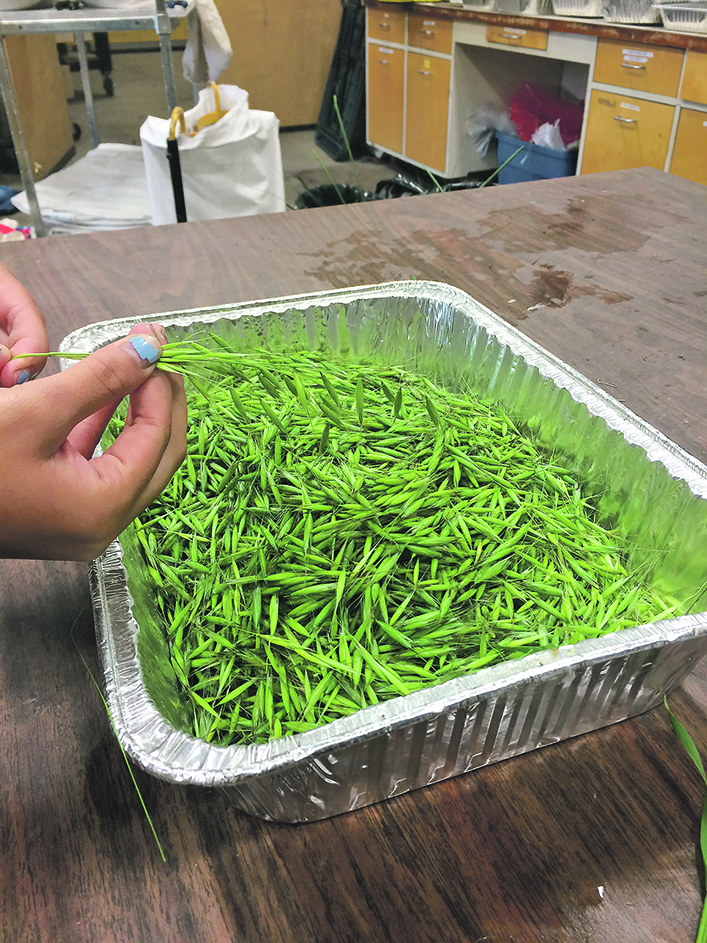Removing weed seeds and stems from standing crop might not impact yields but does affect the seed bank
When you see a wild oat patch sticking up above a crop canopy, you have to wonder if trimming off the tops would reduce the weed pressure in the field.
This is what Breanne Tidemann is analyzing, with the first of her trials recently published in Canadian Agronomist.
“We’ve had questions from farmers, the idea is you can always see wild oats above the crop at the end of July moving into August,” said Tidemann, a research scientist at Agriculture Canada’s research centre in Lacombe, Alta.
Read Also

Growing garlic by the thousands in Manitoba
Grower holds a planting party day every fall as a crowd gathers to help put 28,000 plants, and sometimes more, into theground
“If there is a height differential, could we cut the wild oat panicles off and either prevent the seeds from forming and being fully viable or prevent the seed set at all.”
The trial was set up in Lacombe and Saskatoon with the help of Steve Shirtliffe, Eric Johnson Christian Willenborg.
Researchers looked at wheat and lentils, to compare opportunities to clip wild oats in a short versus tall crop.
Both crops had a weed-free check and a weedy check to compare yields from the trials.
“Once most of the panicles were emerging out of the boot on the wild oat, that’s when we started clipping,” Tidemann said.
Up to six weekly clippings were conducted.
The first clipping occurred when several wild oat panicles were visible above crop canopies, while the last clipping occurred when seed shed began.
Previous work has shown that once wild oat seeds start shedding, most of the seeds are viable, so there is no point to cutting the panicles at that stage.
Hand clippers were used to clip the wild oats and seeds were tested for viability.
A second study Tidemann is working on allows the panicles to drop and then will observe how that affects the wild oat population.
“We took the panicles and we stripped the seeds off of them. Half of the seeds we weighed, dried weighed again to get the percent moisture. To see if that was something we could use to predict viability,” Tidemann said.
Researchers measured the awn angle of the other seeds to see if the angle can be used to predict seed viability.

“We were surprised at how early wild oat seed viability actually occurs. So even at panicle emergence, you can have around 10 percent of those seeds that will actually be viable and produce plants,” Tidemann said.
She noted the tests were done in sterile petri-dish conditions and seed viability may be lower in field conditions. As well, re-tillering and re-growth were not measured in the study.
“Seed viability begins early and increases quickly over time,” she said.
“Based on the viability alone, it looks like clipping earlier is better than clipping later.”
Researchers also found they could get at the full wild oat panicles in lentils due to the height of the crop compared to the wild oats, but in wheat some wild oat seeds were below the wheat canopy.
“That makes a big impact because you can’t even target all of those seeds like you can in lentils.”
“It becomes pretty obvious pretty quickly that short crops are going to be better for this type of weed management option.”
Neither moisture nor the measured awn angle worked well to predict seed viability.
Tidemann said the moisture measurement may have been affected by some of the tiller re-growth.
She said awn angle had a minor relationship with viability, but a slight change in angle degree could signal a fairly big change in viability and it’s not an easy measurement to make.
She said more research is needed, but the practice of clipping wild oats could fit into an integrated weed management strategy, especially in a short crop.
Growers might focus on patch management. A few commercial pieces of equipment are available that can clip on a large scale, such as a CombCut with an extension and the Weed Clipper built by Bourgault Tillage Tools.
Researchers saw no impact on yield, but they didn’t expect one because the effect on yield from the weeds occurs early in the year.
“If you don’t have any herbicide that work anymore with your wild oats because of resistance, and when you do grow a short crop like lentils it can be a way to at least prevent seed production,” Tidemann said.
To read the study, go to https://bit.ly/3gipXpJ.


















